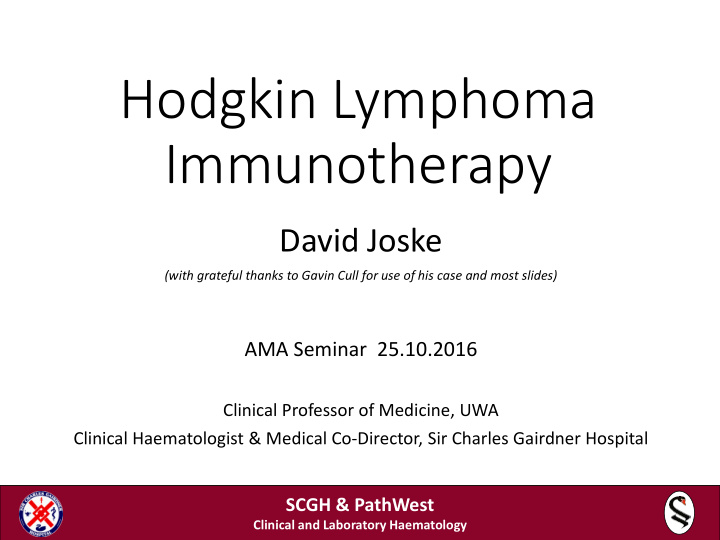



Hodgkin Lymphoma Immunotherapy David Joske (with grateful thanks to Gavin Cull for use of his case and most slides) AMA Seminar 25.10.2016 Clinical Professor of Medicine, UWA Clinical Haematologist & Medical Co-Director, Sir Charles Gairdner Hospital SCGH & PathWest Clinical and Laboratory Haematology
Hodgkin Lymphoma Reed-Sternberg cells First described by Thomas Hodgkin in 1832. A B-cell lymphoma not expressing B-cell surface antigens. Biological hallmark is large inflammatory response. Four variants, little effect upon prognosis. Incidence peaks: adolescents & young adults, then again in elderly. Often presents with itch, large mediastinal mass. SCGH & PathWest Clinical and Laboratory Haematology
17 year old male • Classical Hodgkin lymphoma (nodular sclerosis subtype) diagnosed September 2014 • Multi-agent chemotherapy completed April 2015 (CMR; early relapse) • Gemcitabine/rituximab 2 cycles • BEAM + ASCT June 2015 • Relapsed disease August 2015 • R-HiDICE with Brentuximab Vedotin (2 cycles) • IFRT (36 Gy) • Progressive disease January 2016 SCGH & PathWest Clinical and Laboratory Haematology
17 year old male • Referred to SCGH • Commenced Nivolumab fortnightly 3mg/kg IVI • Admitted shortly faster 1 st infusion with chest pain and shortness of breath SCGH & PathWest Clinical and Laboratory Haematology
17 year old male • Admitted to ICU • Pleural drainage • Pericardial drainage • Commenced ChlVPP • Improved • Discharged home from ICU • Nivolumab continued • 3-weekly infusion SCGH & PathWest Clinical and Laboratory Haematology
BV 1.8mg/kg IV over 30 mins Once every 3 weeks Up to 16 cycles Median cycles = 10 SCGH & PathWest Clinical and Laboratory Haematology
SCGH & PathWest Clinical and Laboratory Haematology
CR Patients • 34/102 (33%) • Median duration of response not reached • 5 years OS 64% and PFS 52% • 13 CR patients remain in remission at study closure • 4 underwent a consolidative allo-SCT • 9 no further treatment (26% of all CR patients) SCGH & PathWest Clinical and Laboratory Haematology
BV side-effects • Peripheral neuropathy • Incidence 55% • Resolution or improvement in 88% after BV • Nausea • Fatigue • Neutropenia • Diarrhoea SCGH & PathWest Clinical and Laboratory Haematology
Conclusion • Among patients with relapsed/refractory Hodgkin lymphoma after ASCT, a substantial fraction of patients who obtained CR with single agent brentuximab vedotin have achieved long-term disease control and may potentially be cured. SCGH & PathWest Clinical and Laboratory Haematology
Checkpoint blockade SCGH & PathWest Clinical and Laboratory Haematology
Background • PD-1 ligands are overexpressed in R-S cells of classical HL • Amplification of 9p24.1 upregulates the genes for PD-1 ligands • The 9p24.1 amplicon also activates JAK-STAT which further induces PD-1 ligand • EBV infection also increases PD-1 ligand in EBV+ cHL • Features suggest cHL may be vulnerable to PD-1 blockade SCGH & PathWest Clinical and Laboratory Haematology
SCGH & PathWest Clinical and Laboratory Haematology
Checkmate 205: Nivolumab in Classical Hodgkin Lymphoma After Autologous Stem Cell Transplant and Brentuximab Vedotin, a Phase 2 Study
Checkmate 205: Study Design, Cohort B
Patient Characteristics and Disposition
Objective Response Rate and <br />Best Overall Responses to Therapy
Tumor Burden Change from Baseline <br />(All Response-Evaluable Patients)
Survival
Adverse Events
Conclusions
Conclusions • Brentuximab vedotin and nivolumab are novel immunotherapeutic agents • Effective in chemo-resistant lymphoma • In some circumstances may be curative; otherwise could be a so-called bridge to allogeneic BMT • Financial implications to the health care system are considerable
Recommend
More recommend